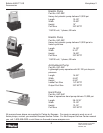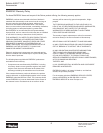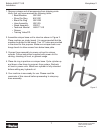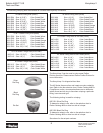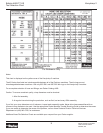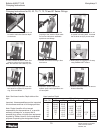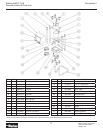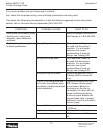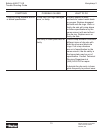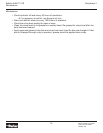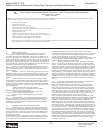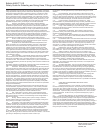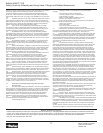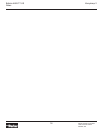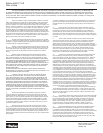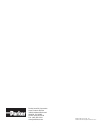
Bulletin 4480-T7-US Karrykrimp 2
Parker Hannifin Corporation
Hose Products Division
Wickliffe, OH
17
• Damaged, cracked, cut or abraded cover (any reinforcement
exposed);
• Hard, stiff, heat cracked, or charred Hose;
• Cracked, damaged, or badly corroded Fittings;
• Leaks at Fitting or in Hose;
• Kinked, crushed, flattened or twisted Hose; and
• Blistered, soft, degraded, or loose cover.
4.3 Visual Inspection All Other: The following items must be tightened,
repaired, corrected or replaced as required:
• Leaking port conditions;
• Excess dirt buildup;
• Worn clamps, guards or shields; and
• System fluid level, fluid type, and any air entrapment.
4.4 Functional Test: Operate the system at maximum operating pressure
and check for possible malfunctions and leaks. Personnel must avoid potential
hazardous areas while testing and using the system. See section 2.2.
4.5 Replacement Intervals: Hose assemblies and elastomeric seals used
on Hose Fittings and adapters will eventually age, harden, wear and deteriorate
under thermal cycling and compression set. Hose Assemblies and elastomeric
seals should be inspected and replaced at specific replacement intervals, based on
previous service life, government or industry recommendations, or when failures
could result in unacceptable downtime, damage, or injury risk.
See section 1.2.
4.6 Hose Inspection and Failure: Hydraulic power is accomplished by
utilizing high-pressure fluids to transfer energy and do work. Hoses, Fittings, and
Hose Assemblies all contribute to this by transmitting fluids at high pressures.
Fluids under pressure can be dangerous and potentially lethal and, therefore,
extreme caution must be exercised when working with fluids under pressure and
handling the Hoses transporting the fluids. From time to time, Hose Assemblies
will fail if they are not replaced at proper time intervals. Usually these failures are
the result of some form of misapplication, abuse, wear, or failure to perform proper
maintenance. When Hoses fail, generally the high-pressure fluids inside escape
in a stream which may or may not be visible to the user. Under no circumstances
should the user attempt to locate the leak by “feeling” with their hands or any other
part of their body. High-pressure fluids can and will penetrate the skin and cause
severe tissue damage and possibly loss of limb. Even seemingly minor hydraulic
fluid injection injuries must be treated immediately by a physician with knowledge of
the tissue damaging properties of hydraulic fluid.
If a Hose failure occurs, immediately shut down the equipment and leave the area
until pressure has been completely released from the Hose Assembly. Simply
shutting down the hydraulic pump may or may not eliminate the pressure in the
Hose Assembly. Many times check valves, etc., are employed in a system and can
cause pressure to remain in a Hose Assembly even when pumps or equipment
are not operating. Tiny holes in the Hose, commonly known as pinholes, can eject
small, dangerously powerful but hard to see streams of hydraulic fluid. It may take
several minutes or even hours for the pressure to be relieved so that the Hose
Assembly may be examined safely.
Once the pressure has been reduced to zero, the Hose Assembly may be taken off
the equipment and examined. It must always be replaced if a failure has occurred.
Never attempt to patch or repair a Hose Assembly that has failed. Consult the
nearest Parker distributor or the appropriate Parker division for Hose Assembly
replacement information.
Never touch or examine a failed Hose Assembly unless it is obvious that the Hose
no longer contains fluid under pressure. The high-pressure fluid is extremely
dangerous and can cause serious and potentially fatal injury.
4.7 Elastomeric seals: Elastomeric seals will eventually age, harden, wear
and deteriorate under thermal cycling and compression set. Elastomeric seals
should be inspected and replaced.
4.8 Refrigerant gases: Special care should be taken when working with
refrigeration systems. Sudden escape of refrigerant gases can cause blindness if
the escaping gases contact the eye and can cause freezing or other severe injuries
if it contacts any other portion of the body.
4.9 Compressed natural gas (CNG): Parker CNG Hose Assemblies should
be tested after installation and before use, and at least on a monthly basis per AGA
1-93 Section 4.2 “Visual Inspection Hose/Fitting”. The recommended procedure
is to pressurize the Hose and check for leaks and to visually inspect the Hose for
damage.
Caution: Matches, candles, open flame or other sources of ignition shall not be
used for Hose inspection. Leak check solutions should be rinsed off after use.
that does not specify a Parker Fitting, the user is solely responsible for the selection
of the proper Fitting and Hose Assembly procedures. See instruction 1.4.
The Parker published instructions must be followed for assembling the Fittings
on the Hose. These instructions are provided in the Parker Fitting catalog for the
specific Parker Fitting being used, or by calling 1-800-CPARKER, or at www.parker.
com.
3.3 Related Accessories: Do not crimp or swage any Parker Hose or Fitting
with anything but the listed swage or crimp machine and dies in accordance with
Parker published instructions. Do not crimp or swage another manufacturers Fitting
with a Parker crimp or swage die unless authorized in writing by the engineering
manager of chief engineer of the appropriate Parker division.
3.4 Parts: Do not use any Parker Fitting part (including but not limited
to socket, shell, nipple, or insert) except with the correct Parker mating parts, in
accordance with Parker published instructions, unless authorized in writing by the
engineering manager or chief engineer of the appropriate Parker division.
3.5 Reusable/Permanent: Do not reuse any field attachable (reusable)
Hose Fitting that has blown or pulled off a Hose. Do not reuse a Parker permanent
Hose Fitting (crimped or swaged) or any part thereof. Complete Hose Assemblies
may only be reused after proper inspection under section 4.0. Do not assemble
Fittings to any previously used hydraulic Hose that was in service, for use in a fluid
power application.
3.6 Pre-Installation Inspection: Prior to installation, a careful examination
of the Hose Assembly must be performed. Inspect the Hose Assembly for any
damage or defects. Do NOT use any Hose Assembly that displays any signs of
nonconformance.
3.7 Minimum Bend Radius: Installation of a Hose at less than the minimum
listed bend radius may significantly reduce the Hose life. Particular attention must
be given to preclude sharp bending at the Hose to Fitting juncture. Any bending
during installation at less than the minimum bend radius must be avoided. If any
Hose is kinked during installation, the Hose must be discarded.
3.8 Twist Angle and Orientation: Hose Assembly installation must be such
that relative motion of machine components does not produce twisting.
3.9 Securement: In many applications, it may be necessary to restrain,
protect, or guide the Hose to protect it from damage by unnecessary flexing,
pressure surges, and contact with other mechanical components. Care must be
taken to insure such restraints do not introduce additional stress or wear points.
3.10 Proper Connection of Ports: Proper physical installation of the Hose
Assembly requires a correctly installed port connection insuring that no twist or
torque is transferred to the Hose when the Fittings are being tightened or otherwise
during use.
3.11 External Damage: Proper installation is not complete without insuring
that tensile loads, side loads, kinking, flattening, potential abrasion, thread damage,
or damage to sealing surfaces are corrected or eliminated. See instruction 2.10.
3.12 System Checkout: All air entrapment must be eliminated and the system
pressurized to the maximum system pressure (at or below the Hose maximum
working pressure) and checked for proper function and freedom from leaks.
Personnel must stay out of potential hazardous areas while testing and using.
3.13 Routing: The Hose Assembly should be routed in such a manner so if
a failure does occur, the escaping media will not cause personal injury or property
damage. In addition, if fluid media comes in contact with hot surfaces, open flame,
or sparks, a fire or explosion may occur. See section 2.4.
4.0 HOSE AND FITTING MAINTENANCE AND REPLACEMENT
INSTRUCTIONS
4.1 Even with proper selection and installation, Hose life may be significantly
reduced without a continuing maintenance program. The severity of the application,
risk potential from a possible Hose failure, and experience with any Hose failures
in the application or in similar applications should determine the frequency of the
inspection and the replacement for the Products so that Products are replaced
before any failure occurs. A maintenance program must be established and
followed by the user and, at minimum, must include instructions 4.2 through 4.7.
4.2 Visual Inspection Hose/Fitting: Any of the following conditions require
immediate shut down and replacement of the Hose Assembly:
• Fitting slippage on Hose,
MSDS’S (Available upon request.)
Federal OSHA regulation 29 CFR 1910.1200 requires that we transmit to our customers Material Safety Data Sheets for all material covered under
the law. If you are an employer in SIC 20-39 who has not yet received them, you are required to obtain them from us and provide the information to
employees as directed in Secton (b) of the requlation. Please contact the Hose Products Division - Technical Services Department:
(PH) 440- 943-5700 (FAX) 440- 943-3129.
Safety Guide for Selecting and Using Hose, Fittings and Related Accessories



